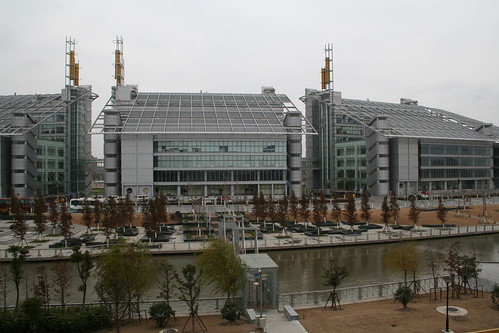It was a sunny afternoon (update: it quickly turns into thunderstorm tonight), and Yifan fall asleep. There is nothing for Wendy and I to do – pretty rare in the last two years, so we cherished the great opportunity to wander around. Wendy had a crazy idea, and I was even more crazier than her: I agreed.
The idea was, to drive 35 km away to Microsoft Shanghai’s new campus in Zizhu Science and Technology Center. The construction of this center is pretty important to us, since Microsoft is moving most of its technical people to that center, which, unfortunately, including Wendy.
Zizhu Science and Technology Park
Shanghai Zizhu Science and Technology Park 紫竹高科技园区 is located at the far south side of Minhang district. It is pretty far from the city. If you have some concepts of Shanghai Metro system, it is at the south end of the Metro Line #5 (to provide you some hits, Metro Line #1 is the north-south line in Shanghai. Metro Line #5 starts from the most south station of Metro Line #1. Got some idea about how far it is?).
The area became hot because Shanghai Jiao Tong University moved from it Xuhui Campus to the Minghang Campus in 1984, and continued to expand the area of the campus. I have spent 2 years studying on that campus, before I was relocated to the main Xuhui Campus. I left the campus in 1999, and got back to the Xuhui Campus in 2007, with a company setting up there.
The Change of Zizhu Park
The Zizhu Park was just a concept when I was there from 1995 to 1997. There are no buildings, and even more roads. If you check out Google Satellite map today, you still see almost nothing.
Later, some companies moved in, including Microsoft, Wicresoft (Microsoft’s joint venture, where I also spent about half a year), Intel. The area became a “real” science park. All of them was squeezed into several public buildings.

Image in courtesy of Zhou, Xiaohui

Image in courtesy of jeffwilcox
Recent few years ago, Intel built their campus there, and many people of Intel moved there. Then Wicresoft – a Wicresoft building and a campus. Then Omren…

Image in courtesy of jeffwilcox
Microsoft Zizhu Campus
The Microsoft Zizhu Campus was designed to be a huge project. The big complex consists of four buildings and a big cafeteria in the middle. The current project only includes the cafeteria and one building.
When finished, all Microsoft Shanghai technical resources will be moved there. To name a few: Microsoft Global Technical Center, Microsoft Advanced Technical Center, and many divisions of Microsoft Live Development Center. To be short, almost all the people I know in Microsoft moved there, except the Microsoft Shanghai Sales and Marketing Organization (they will move to the Grand Gateway).

Image in courtesy of jeffwilcox
Transportation is a Huge Problem
Zizhu Science Park is pretty nice. It is obviously not as popular in hi-tech companies as Zhang Jiang Hi-Tech Park. But it is catching up. The arrangement of the new Microsoft Zizhu campus is also very attractive – with VIP in-house health care, and sports facility, but the key problem of this campus is, it is too far away.
Wendy has tried every thing to find the best way to get to that campus. She tried to use normal route of A20 -> A4, or tried A20 -> Lianhua Road, or even tried to use Ferry at the Metro Line #8 station. The reason is discouraging. The campus is at least 35 km away from our home, and up to 60 km away from some of the engineers working there. That means, you need to prepare at least 2-3 hours on transportation to get there. Hmmm…. It is really to far away.
Let’s see how things evolves, when the moving day comes for the many different groups with nearly 1000 people.
Photos?
I hope I can upload the photo of the new building now, but it is still in Wendy’s mobile phone, and I am still looking for a connection cable. I will update when I have photos available.






















